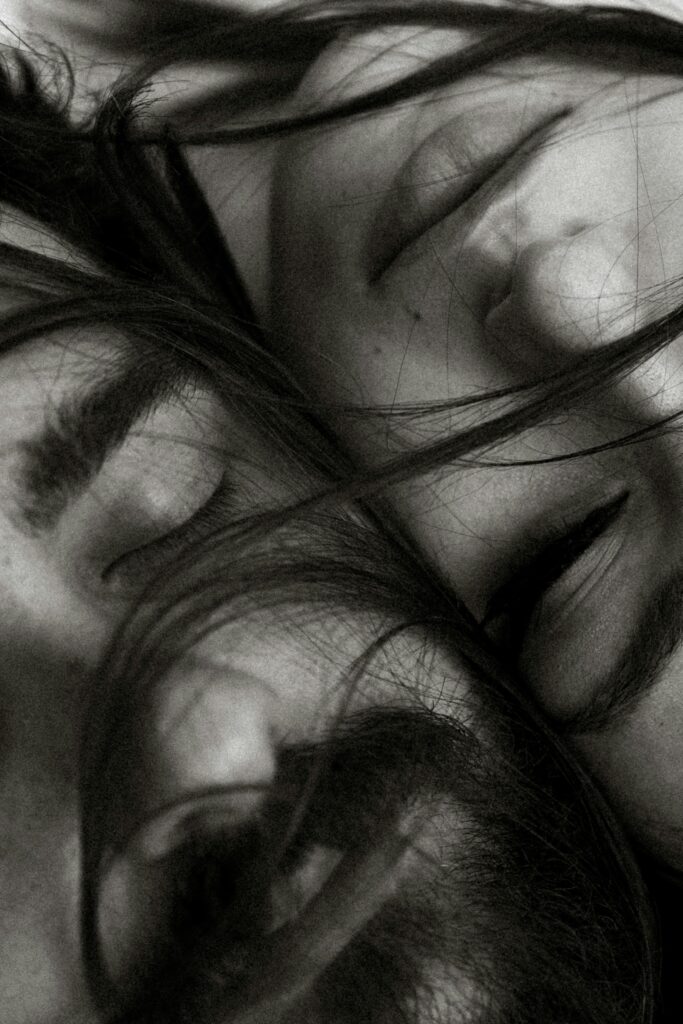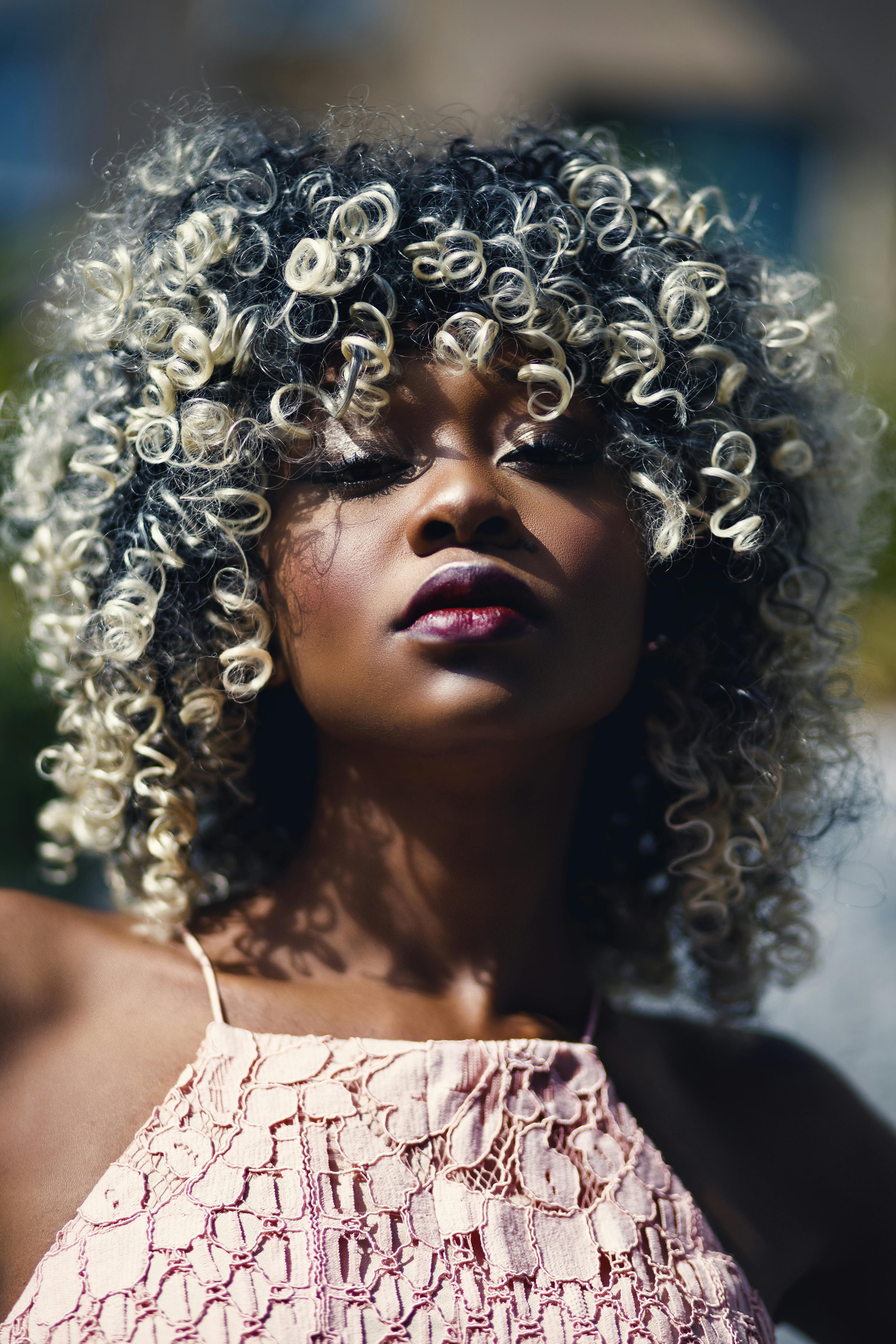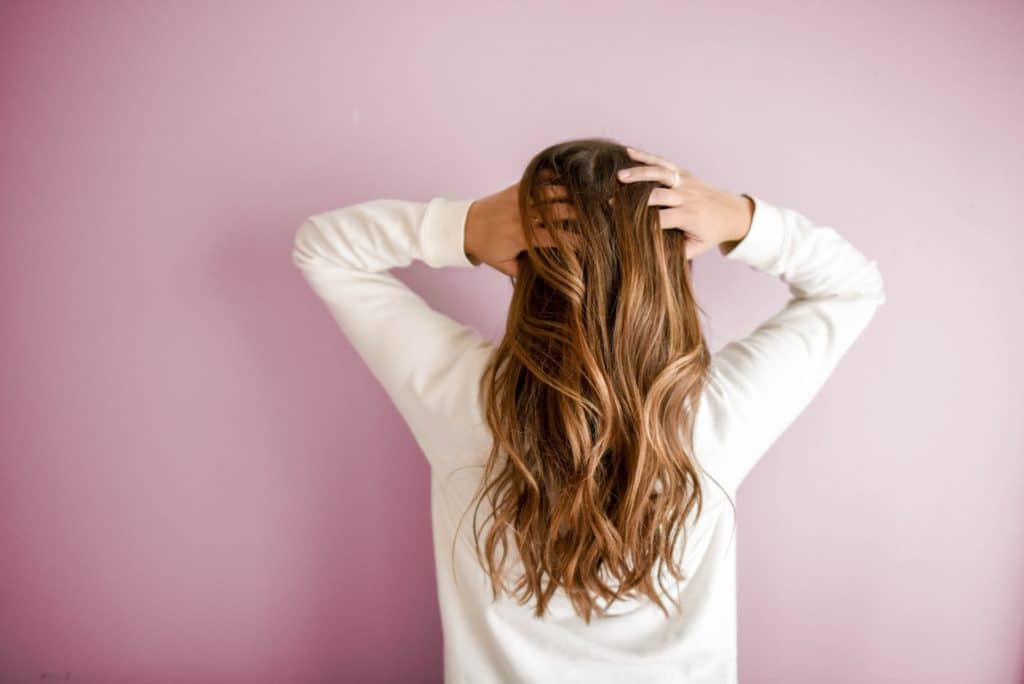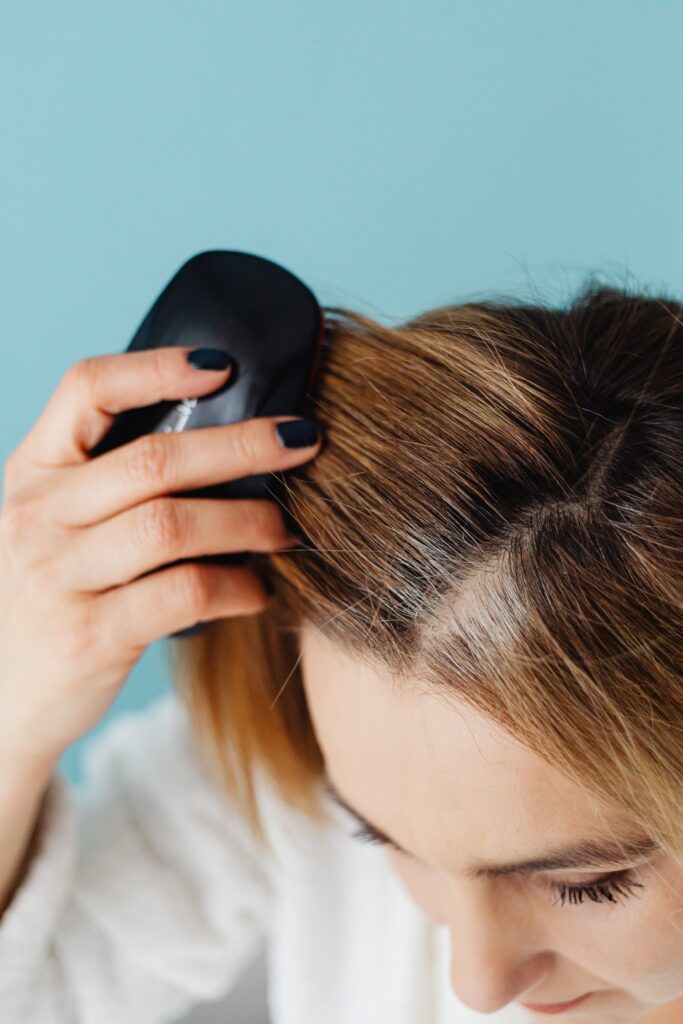A Comprehensive Guide to Healthy Hair Care
Today, we’re delving deep into the realm of healthy hair care, uncovering the mysteries behind achieving and maintaining healthy hair, and luscious, radiant locks.
Whether you’re battling frizz, longing for length, or simply seeking to enhance your hair’s natural beauty, this guide is your ultimate roadmap to hair nirvana.

A Comprehensive Guide to Healthy Hair Care
In this article we’ll be covering –
- Understanding your Hair Type
- The Fundamentals of Hair Care
- Tips for Healthy Hair
- Nourishing Hair from Within
- The Power of Moisture
- Styling for Success
- Troubleshooting Common Concerns
- FAQs
Understanding Your Hair Type
Before diving headfirst into a new hair care routine, it’s crucial to understand your unique hair type. Is your hair straight as an arrow, cascading in luxurious waves, or tightly coiled like springs?
This is important because haircare for straight hair vs curly hair isn’t the same! To best take care of your hair, you have to know what hair type you have.
Type 1 hair is more or less straight, 1A, 1B, 1C.
Type 2 hair is several variations of wavy, 2A, 2B, 2C.
Type 3 hair is when hair is curly, from Beach Waves to Shirley Temple. 3A, 3B, 3C.
Type 4 hair is extra curly and coily- think variations of an afro. 4A, 4B, 4C.
By identifying your hair’s texture, density, and porosity, you can tailor your regimen to meet its specific needs, ensuring optimal results with every wash and style.

The Fundamentals of Hair Care
Building a solid foundation for healthy hair begins with the basics.
✔️ Using a shampoo and hydrating conditioner that properly cleanses and hydrates your scalp and hair. And doesn’t contain toxic ingredients that slow growth or cause further hair damage.
✔️ Listening to your body’s needs, because the hair is an afterthought when it comes to your body’s overall health. If the body is healthy the hair is healthy too.
❌ Not over-washing your hair that dries the scalp and hair and causes more wear and tear because of the water, combing and detangling, drying, and styling the hair too often.
✔️ Get regular trims, because wear and tear happens to everyone and to keep the hair healthy you have to trim off the brokenness on the ends.
Tips for Healthy Hair Growth
There are countless factors to healthy hair growth, blood circulation
- Nutrient-Rich Diet: Consume foods rich in vitamins, minerals, and protein to support healthy hair growth, including leafy greens, berries, nuts, fish, and lean meats.
- Scalp Massage: Stimulate blood flow to the scalp and promote hair growth by gently massaging your scalp with your fingertips or a scalp massager.
- Regular Trims: Keep split ends at bay and encourage healthy hair growth by scheduling regular trims every 6-8 weeks to remove damaged ends and prevent breakage.
- Minimize Stress: Practice stress-reduction techniques such as meditation, yoga, or deep breathing exercises to minimize hair loss associated with stress hormones.
- Avoid Tight Hairstyles: Opt for looser hairstyles that don’t pull or tug on your hair follicles, as tight styles can lead to traction alopecia and hinder healthy hair growth.

What is a Healthy Hair Routine?
A healthy hair care routine encompasses a series of practices aimed at maintaining the overall health and vitality of your hair.
This includes regular cleansing and conditioning with gentle, nourishing products, as well as incorporating deep conditioning treatments and scalp massages to promote moisture retention and stimulate hair growth.
Protecting your hair from environmental stressors and minimizing heat styling help prevent damage and breakage, while adopting a nutrient-rich diet supports optimal hair health from the inside out.
What to Eat for Healthy Hair
- Salmon: Rich in omega-3 fatty acids, salmon promotes scalp health and encourages hair growth while adding shine and luster to your strands.
- Avocado: Packed with vitamins E and B, avocados moisturize and nourish the scalp, reducing dryness and preventing hair breakage.
- Spinach: High in iron and vitamins A and C, spinach supports healthy hair growth by promoting circulation to the scalp and strengthening hair follicles.
- Walnuts: A good source of biotin, walnuts help prevent hair loss and support the production of keratin, the protein that makes up your hair.
- Eggs: Loaded with protein, biotin, and zinc, eggs provide essential nutrients for strong, healthy hair growth while repairing damage and promoting shine.
What to Eat to Stop Hair Fall Immediately – 40 Tips from a Hairstylist
10 Tricks for Healthier Fuller Hair
These tips are for all hair types, it’s simply the products that you use for your hair type that should be more specific.

For example, skip blow drying your hair if you have a curly hair type, or use a more volumizing shampoo and conditioner for straighter hair.
- Use a Scalp Scrub: Exfoliate your scalp regularly to remove buildup and stimulate hair follicles for healthier, fuller-looking hair.
- Incorporate Hair Masks: Treat your hair to weekly deep conditioning masks to hydrate, strengthen, and add volume to your strands.
- Try a Volumizing Shampoo: Use a volumizing shampoo to add body and lift to your hair, creating the illusion of fuller, thicker strands.
- Blow-Dry Upside Down: Flip your head upside down while blow-drying to create volume at the roots and lift your hair away from the scalp.
- Use a Root Lifter: Apply a root lifting spray or mousse to damp hair before styling to add volume and lift at the roots.
- Avoid Heavy Products: Opt for lightweight styling products that won’t weigh your hair down, allowing it to move freely and appear fuller.
- Brush with Care: Use a boar bristle brush to distribute natural oils and add shine, but avoid over-brushing, which can cause breakage and thinning.
- Choose the Right Haircut: Opt for layers or a blunt cut to add volume and movement to your hair, giving the appearance of fuller locks.
- Sleep on Silk: Switch to a silk or satin pillowcase to reduce friction and prevent hair breakage while you sleep, preserving your hair’s volume and texture.
- Stay Hydrated: Drink plenty of water to keep your hair hydrated from the inside out, promoting healthy growth and preventing dryness and breakage.
19 Ways to Protect Hair from Cold for All Hair Types
15 Homemade Hair Treatments for Black Hair Curl Type 4A, 4B, 4C – Expert Approved
Healthy Hair Care- Nourishing From Within
True radiance starts from within, and your hair is no exception. A balanced diet rich in essential nutrients, such as vitamins A, C, E, and biotin, provides the building blocks your hair needs to thrive.
The best foods for promoting hair growth, strengthening follicles, and combatting common concerns like dryness and breakage.
Can Vitamins Cause Hair Loss? Other Nutrient Deficiencies Cause Hair Loss?
The Power of Moisture
Moisture is the lifeblood of healthy hair, helping to maintain elasticity, prevent brittleness, and enhance shine.

The science of hydration, exploring the role of humectants, emollients, and occlusives in locking in moisture and combating dryness. Whether you’re battling humidity-induced frizz or parched strands in need of hydration, we’ll unveil the best practices and products for achieving and maintaining optimal moisture balance.
The power of moisture for hair cannot be overstated—it is fundamental to maintaining healthy, vibrant, and manageable hair. Moisture is crucial because –
- Hydration and Elasticity: Moisture keeps hair flexible and resilient, preventing it from becoming brittle and prone to breakage. Well-hydrated hair retains its natural elasticity, allowing it to withstand daily styling and environmental stressors.
- Enhanced Shine and Smoothness: Moisture-rich hair reflects light better, resulting in a glossy and smooth appearance. It reduces frizz and static, making hair easier to style and enhancing its overall texture.
- Improved Manageability: Dry hair tends to be unruly and difficult to style. Adequate moisture helps in detangling and combing, making it easier to manage and reducing the risk of damage during grooming.
- Protection Against Damage and Breakage: Moisture acts as a barrier against external elements such as sun exposure, humidity, and pollutants. It helps to maintain the hair’s natural protective layer, preventing moisture loss and damage.
- Supports Growth and Health: Proper moisture levels contribute to a healthy scalp environment, which is essential for hair growth. Well-moisturized hair follicles are less likely to experience issues like dandruff or scalp irritation, promoting optimal hair health.
- Color Retention: For colored or chemically treated hair, moisture helps preserve the vibrancy of the color and prevents it from fading prematurely. It also reduces the risk of damage caused by chemical treatments.
- Overall Appearance: Ultimately, well-moisturized hair looks and feels better. It has a natural bounce and vitality that enhances your overall appearance and boosts your confidence.
Incorporating moisturizing treatments and products into your hair care routine is key to harnessing the power of moisture for healthier, more beautiful hair. Whether through hydrating shampoos, conditioners, masks, or natural remedies, maintaining optimal moisture levels is essential for hair that shines with vitality.
Troubleshooting Common Concerns for Healthy Hair Care

No hair journey is without its challenges, but fear not – we’ve got you covered! In this final portion of this article, we’ll address these common hair concerns –
- Dandruff
- Scalp irritation
- Thinning
- Split ends
Dandruff – A lot of times people misinterpret dry scalp for dandruff. Both are flaky but only one is oily and stinky as well – true dandruff! It can be easily treated with a medicated shampoo that can dry out the fungal flaky annoyance and clear up the beautiful skin underneath.
15 Tips for Overnight Dandruff Treatment – Dandruff vs Dry Scalp
Scalp Irritation –
Several factors can irritate the scalp, leading to discomfort and potentially impacting overall hair health. Understanding these triggers can help you avoid them and begin helpful habits to maintain healthy hair.
- Harsh Chemicals – Hair products containing sulfates, parabens, and artificial fragrances can strip the scalp of its natural oils, leading to dryness and irritation.
- Overwashing – Excessive washing can disrupt the scalp’s natural balance, stripping away essential oils and causing dryness or itchiness.
- Heat Styling – High temperatures from hair dryers, curling irons, and straighteners can dry out the scalp and exacerbate existing irritation.
- Tight Hairstyles – Styles that pull tightly on the scalp, such as braids, ponytails, or tight buns, can cause friction and inflammation.
- Allergens – Some people may be sensitive to certain ingredients in hair products, including preservatives, dyes, or fragrances, which can trigger allergic reactions or irritation.
- Environmental Factors – Exposure to harsh weather conditions like extreme heat or cold, as well as pollutants and UV rays, can stress the scalp and lead to irritation.
- Improper Hair Care – Not using the right products for your hair type or failing to rinse products thoroughly can leave residue on the scalp, leading to irritation and potentially clogged pores.
Thinning –
Hair thinning can occur due to various factors, both internal and external. Here are three common reasons why hair may thin –
Genetics (Androgenetic Alopecia) – The most common cause of hair thinning is genetics, also known as androgenetic alopecia. This condition is hereditary and can affect both men and women. It typically causes hair follicles to shrink over time, leading to thinner, finer hair and eventually hair loss in susceptible individuals.
Hormonal Changes – Hormonal imbalances, such as those caused by pregnancy, childbirth, menopause, or thyroid disorders, can contribute to hair thinning. These fluctuations can affect the hair growth cycle, leading to shedding or decreased hair density.
Nutritional Deficiencies – Inadequate intake of essential nutrients, such as vitamins (especially B vitamins like biotin), minerals (like iron and zinc), and proteins, can impact hair health. Poor nutrition can weaken hair follicles, leading to thinning and dullness of hair strands.
Other potential causes of hair thinning include stress, certain medications, underlying medical conditions, and excessive hairstyling practices (like tight hairstyles or frequent use of heat styling tools).
Identifying the specific cause of hair thinning is crucial for determining appropriate treatment options, which may include dietary changes, lifestyle adjustments, medical treatments, or specialized hair care products.
Hairstyles for Thinning Hair – 45 Ideas, Causes, and Solutions from a Hairstylist
Split Ends –
Split ends, or trichoptilosis – which is broken hair strands – occur when the protective cuticle layer of the hair shaft breaks or frays, exposing the inner cortex and leading to dry, brittle strands.
Common culprits include excessive heat styling, chemical treatments, mechanical stress from brushing or tight hairstyles, and environmental factors like UV rays and pollutants.
To combat this issue, regular trims every 6-8 weeks are crucial to remove existing split ends and prevent further damage. Minimizing heat exposure, opting for gentle hair care products, and using wide-toothed combs for detangling can also help.
But remember, incorporating homemade hair masks such as avocado and honey or egg and yogurt can provide natural and deep hydration and nourishment, promoting healthier hair from root to tip. While these methods can improve the appearance of split ends temporarily, the only permanent solution remains regular trims to maintain hair health care.
Do Split Ends Stop Hair Growth? Natural Ways to Prevent Split Ends
How to Get Rid of Split Ends Overnight – Tips from a Hairstylist
Conclusion for
Armed with newfound knowledge and inspiration, you’re poised to embark on your own journey to hair greatness. Remember, healthy hair is not just a goal – it’s a lifestyle.
So, embrace the process, celebrate your progress, and never underestimate the transformative power of self-care.
Most Commonly Asked Questions for Maintaining Healthy Hair
Do Healthy Hair Supplements Work?
While supplements can provide additional support for healthy hair growth, they are not a substitute for a balanced diet and proper hair care routine.
Supplements containing vitamins, minerals, and other nutrients such as biotin, collagen, and omega-3 fatty acids may help promote hair health and growth when used in conjunction with a healthy lifestyle.
What is the healthiest way to do your hair?
The healthiest way to care for your hair involves adopting a gentle and nourishing hair care routine that respects your hair’s natural integrity. This includes using sulfate-free and paraben-free shampoos and conditioners to cleanse and hydrate without stripping away essential oils.
Additionally, minimizing heat styling and opting for air-drying or low-heat alternatives helps prevent damage and breakage. Regular trims to remove split ends and incorporating deep conditioning treatments can further promote hair health and vitality.

What are 5 Tips to Do your Hair?
- Use the Right Products: Choose hair care products formulated for your specific hair type and concerns, including shampoo, conditioner, and styling products.
- Limit Heat Styling: Minimize heat damage by reducing the frequency of blow-drying, straightening, and curling your hair. When heat styling is necessary, use a heat protectant spray to shield your strands from damage.
- Practice Gentle Handling: Treat your hair with care by avoiding harsh brushing or combing, especially when wet. Instead, use a wide-tooth comb or detangling brush to gently remove knots and tangles, starting from the ends and working your way up.
- Protect Your Hair: Shield your hair from environmental stressors such as sun exposure, chlorine, and pollution by wearing a hat or using protective hairstyles like braids or buns. Additionally, invest in a silk or satin pillowcase to reduce friction and prevent breakage while you sleep.
- Nourish from Within: Maintain a balanced diet rich in vitamins, minerals, and protein to support healthy hair growth and strength. Stay hydrated by drinking plenty of water, and consider incorporating hair-healthy foods such as salmon, avocados, nuts, and leafy greens into your meals.
What is the Healthiest Hair Routine?
A healthy hair care routine involves a combination of cleansing, conditioning, and protective practices tailored to your hair’s unique needs.
This includes –
- Washing your hair regularly with a gentle shampoo and conditioner. Followed by –
- Weekly deep conditioning treatments to replenish moisture and nourish your strands
- Limiting heat styling and incorporating protective hairstyles can help minimize damage
- And get regular trims to keep your ends looking fresh and prevent split ends from traveling up the hair shaft
How Should Healthy Hair be? What Does it Look Like?
Healthy hair should be strong, shiny, and resilient, with a smooth texture and minimal breakage or split ends. It should have a balanced moisture level, neither excessively dry nor overly greasy, and exhibit natural elasticity when stretched.
Healthy hair is also characterized by a well-nourished scalp, free from irritation or flakiness, and supports consistent growth without excessive shedding or thinning.
How to Have Healthy Hair Naturally?
Achieving healthy hair naturally begins with proper care and maintenance, starting from the inside out.
This includes nourishing your body with a balanced diet rich in –
- Vitamins
- Minerals
- Protein
- As well as staying hydrated by drinking plenty of water
Adopting a gentle hair care routine with sulfate-free and paraben-free products helps preserve your hair’s natural oils and prevent damage.
Additionally, incorporating protective hairstyles and minimizing heat styling can promote overall hair health and vitality.
Other FAQs for a Comprehensive Guide to Healthy Hair Care

What is a Healthy Hair Routine?
A healthy hair routine involves consistent care and attention to maintain strong, vibrant hair. Start with –
- A balanced cleansing and conditioning regimen using products suitable for your hair type—opt for sulfate-free shampoos and hydrating conditioners to preserve natural oils.
- Regularly deep condition to replenish moisture and repair damage.
- Minimize heat styling and use heat protectants when necessary.
- Incorporate scalp massages to stimulate circulation and promote hair growth.
- Lastly, protect hair from environmental stressors with UV protection sprays or hats.
Remember, consistency and choosing products that suit your hair’s needs are key to a healthy hair routine.
What to Eat for Healthy Hair
A diet rich in essential nutrients supports healthy hair growth and maintenance. Include foods high in vitamins A, C, D, E, and B-complex vitamins like biotin and folate.
Omega-3 fatty acids found in fish, nuts, and seeds nourish hair follicles and promote scalp health. Incorporate lean proteins like chicken, eggs, and beans, which provide essential amino acids for strong hair strands. Iron-rich foods such as spinach and lentils help prevent hair thinning due to iron deficiency.
But don’t forget, drink plenty of water to stay hydrated, because dehydration can affect hair texture and growth.
10 Tricks for Healthier Fuller Hair
- Scalp Massage: Stimulate blood circulation by massaging your scalp regularly to promote hair growth.
- Use a Wide-Tooth Comb: Minimize breakage by detangling wet hair gently with a wide-tooth comb, starting from the ends and working your way up.
- Limit Heat Styling: Reduce heat damage by air-drying hair whenever possible and using heat protectant sprays before styling.
- Protect from UV Rays: Shield hair from sun damage by wearing hats or using UV protection sprays when outdoors.
- Choose Gentle Hair Products: Opt for sulfate-free shampoos and conditioners to avoid stripping natural oils.
- Stay Hydrated: Drink enough water daily to keep hair hydrated and maintain its elasticity.
- Eat a Balanced Diet: Consume foods rich in vitamins, minerals, and proteins to support hair health from within.
- Regular Trims: Trim hair every 6-8 weeks to prevent split ends and maintain hair health.
- Deep Condition Weekly: Use a nourishing hair mask or conditioner weekly to moisturize and repair hair strands.
- Avoid Tight Hairstyles: Minimize tension on hair follicles by opting for looser hairstyles to prevent breakage and hair loss.
Do Healthy Hair Supplements Work?
Healthy hair supplements can provide nutritional support if deficiencies are contributing to hair issues. Supplements containing biotin, vitamins D and E, and omega-3 fatty acids can promote hair growth and strength.
However, their effectiveness varies, and results may not be immediate. It’s essential to consult with a healthcare provider before starting any supplements, as excessive doses can have adverse effects.
Supplements work best when combined with a balanced diet and a healthy lifestyle that includes proper hair care practices.
Signs your Hair is Unhealthy
Several signs indicate unhealthy hair, including dryness, brittleness, split ends, and excessive shedding.
Dull, lackluster hair that is prone to tangling and breakage suggests insufficient moisture and damage. Scalp issues like dandruff, itchiness, or excessive oiliness can also indicate underlying problems.
Changes in hair texture, such as thinning or loss of volume, may signal hormonal imbalances or nutritional deficiencies.
Pay attention to these signs to address hair health issues promptly and prevent further damage.
Is Hair Loss Unhealthy or Normal?
Hair loss can be a normal physiological process or indicate underlying health issues. Shedding up to 100 hairs per day is considered normal, as hair follicles go through cycles of growth, rest, and shedding.
However, excessive or sudden hair loss, noticeable thinning, or bald patches may be signs of health conditions such as hormonal imbalances, nutritional deficiencies, autoimmune disorders, or stress. It’s essential to consult a healthcare provider or dermatologist if you notice significant hair loss (like you can see through to the scalp when you couldn’t before) to determine the cause and appropriate treatment. Early intervention can often prevent further hair thinning and promote regrowth.

